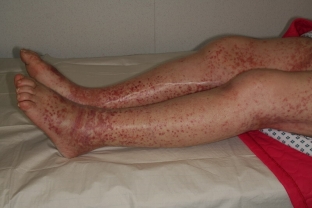Hematological diseases make up the majority of chronic pathologies that are quite difficult to cure, since the cause to be eliminated is very difficult to find. Thus, the main cause of idiopathic thrombocytopenic purpura (ITP) has not yet been clarified. But timely detection and treatment greatly increases the chance for effective treatment and long-term remission. How does thrombocytopenic purpura manifest itself?
When can thrombocytopenic purpura develop?
Thrombocytopenic purpura belongs to the group of hemorrhagic diathesis. There are primary and secondary forms of purpura. The primary form can be hereditary or acquired, develops after an infection. The secondary form is a sign of other diseases. Due to unclear reasons, there is a failure in the bone marrow megakaryocytes, which is manifested by a violation of their functioning.
The development of thrombocytopenic purpura is also possible at the stage of platelet circulation in the blood, when antibodies are formed on them.
Causes of platelet antibodies in thrombocytopenic purpura:
- Surgical intervention.
- Severe overheating or hypothermia of the body.
- Recent trauma.
- Recent vaccinations.
- Development of individual intolerance after taking medications.
- A previous bacterial or viral infection.
Mechanism of development of idiopathic thrombocytopenic purpura
If there are antibodies to their own platelets in the blood, they begin to stick together. This process of intense agglutination leads to the formation of microthrombi and clogging of small vessels. At the same time, platelets stop producing the proper amount of serotonin, which constricts blood vessels. Therefore, the walls of the vessels remain expanded and easily pass blood, contributing to the development of bleeding and hematomas. Against the background of the overlapping of small vessels by microthrombi, less oxygen enters the tissues of the organs, and ischemia of the organs develops.
Thrombocytopenic purpura is characterized not only by a decrease in the number of platelets and their inferiority, but also by disturbances in the blood coagulation system. At the same time, the blood clot that is formed does not have the property of retraction (tightening of the edges of the wound, spontaneous compression), the clot is very loose, which contributes to repeated bleeding. With the development of thrombocytopenic purpura, severe anemia may develop.
Main clinical manifestations of thrombocytopenic purpura
In the acute form of the disease, symptoms develop rapidly and spontaneously. The patient feels a number of non-specific symptoms: nausea, vomiting, weakness, loss of appetite, fever up to 380C, headache, pain in the abdomen or behind the sternum. At the same time, small bruises or hemorrhages are noted on the body, which are not associated with trauma.
A little later, these nonspecific symptoms are joined by symptoms of hemorrhagic syndrome:
- heavy menses or uterine bleeding;
- nosebleeds, bleeding of gums and mucous membranes;
- the presence of hemorrhages in the conjunctiva, sclera, retina, vitreous body, fundus or eardrum;
- hematomas or hemorrhages on the skin;
- gastrointestinal bleeding, presence of blood in the stool;
- blood in the urine due to renal bleeding;
- prolonged bleeding after a tooth extraction procedure that cannot be controlled with medication.

These symptoms of hemorrhagic syndrome have their own characteristics when it comes to Werlhof's disease, or thrombocytopenic purpura.
Main features of the rash in thrombocytopenic purpura
After the appearance of a hemorrhagic rash on the body with thrombocytopenic purpura, the general condition of the patient is further aggravated. There is a sharp increase in temperature, and disturbances in the work of the central nervous system develop. This can be manifested by convulsions, deep pathological sleep, retarded speech, tremor, blurred vision, the development of unilateral paralysis, ataxia, disorientation in space, mental disorders.
Characteristic of the rash in thrombocytopenic purpura:
- bleeding occurs often at night, for no particular reason;
- if bleeding occurs after an injury, the intensity of bleeding does not correspond to the injury;
- elements of hemorrhagic rash vary from small petechiae to large hematomas;
- The color of the elements of the rash is varied, which has acquired the name "shagreen skin"; or "leopard skin";
- hematomas are painless to the touch;
- rash is not symmetrical.
.Thus, if a patient has many non-specific symptoms or neurological symptoms, it is important to do a complete blood count first. This can help to suspect the disease, which will make it possible to properly treat the patient.
For information on how to confirm the diagnosis of thrombocytopenic purpura and how to treat the disease, read the second part of the article on estet-portal.com.







Add a comment